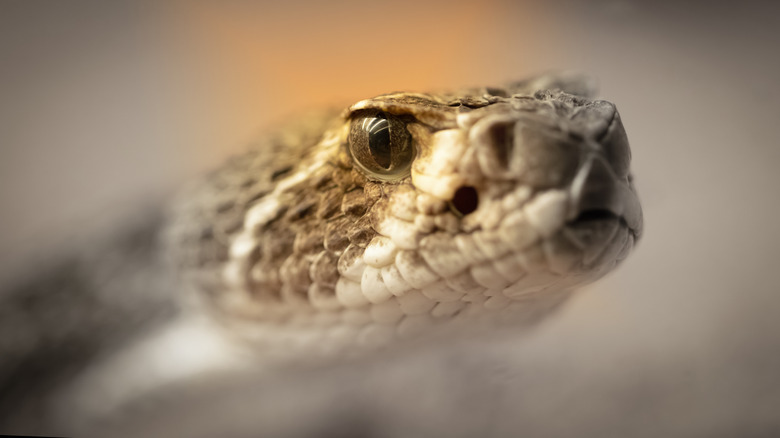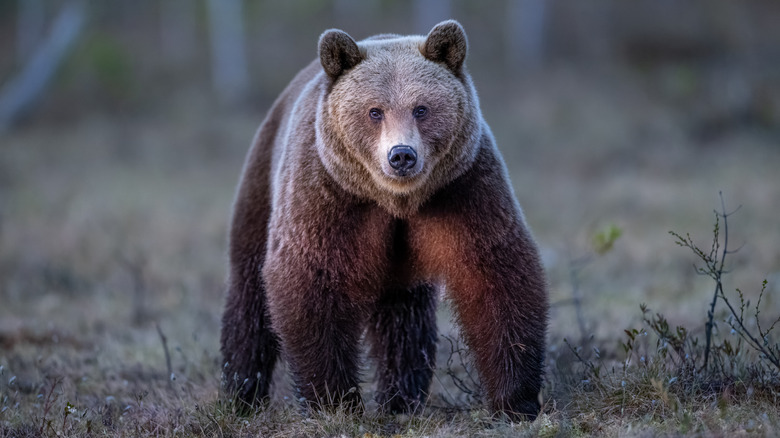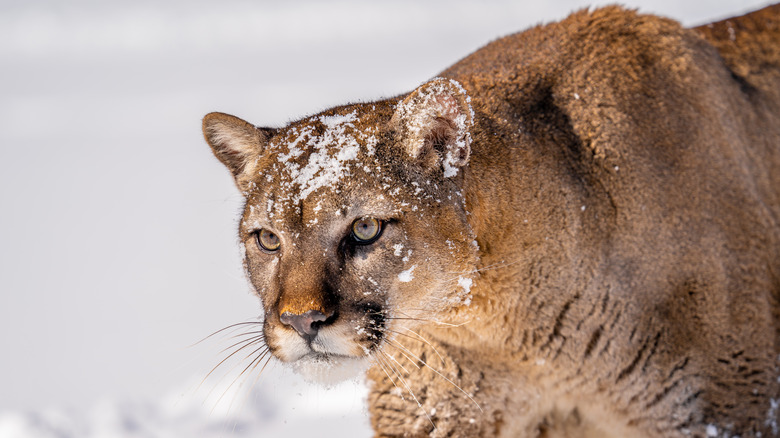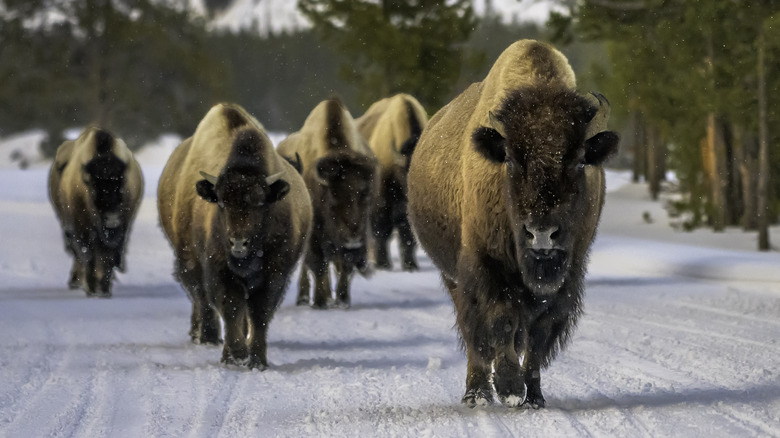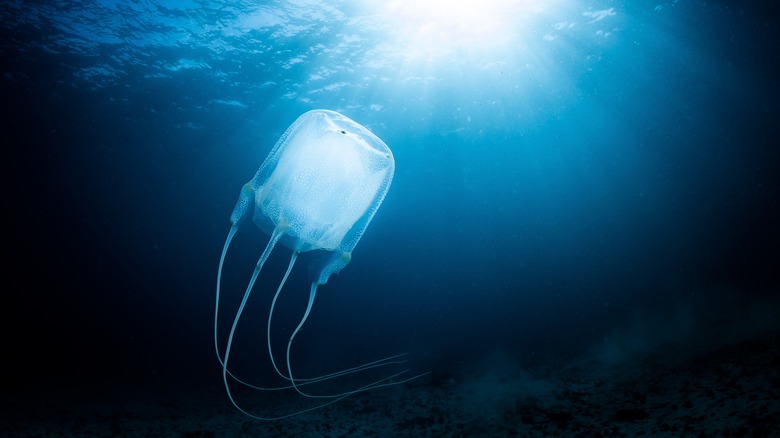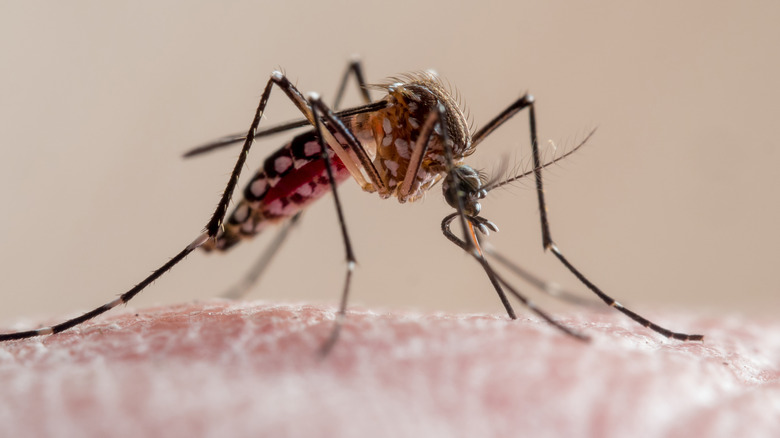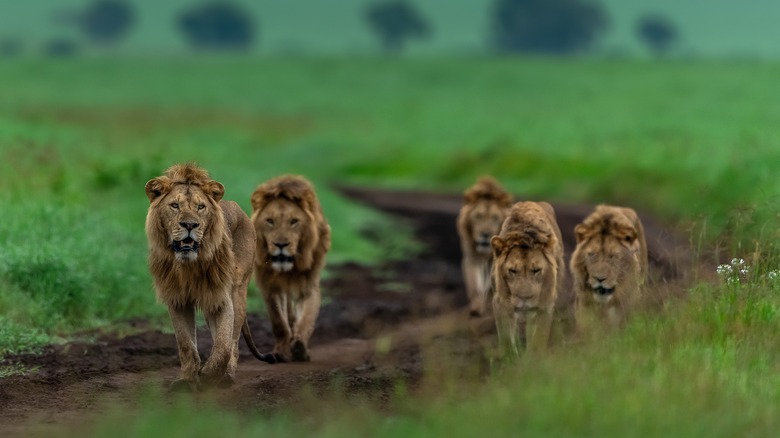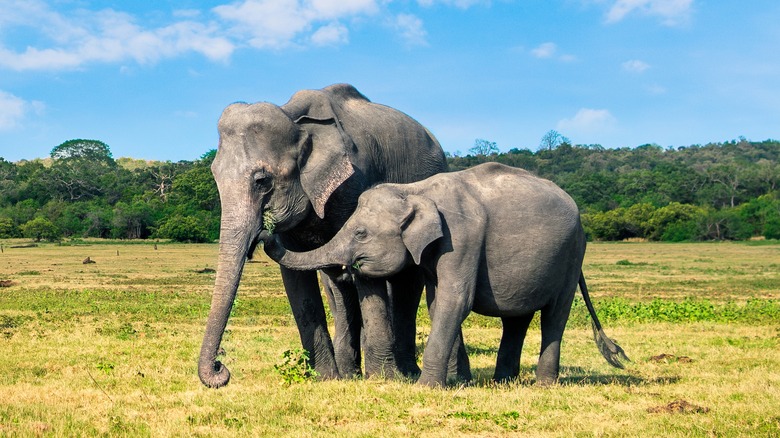10 Wild Animals Tourists Should Avoid At All Costs
When it comes to wildlife, the best travelers are informed ones. Understanding wild animals and how they behave — and how you should behave around them — can be the difference between an amazing experience and a tragic headline. Before venturing into the wilderness or exploring a national park, it is essential to learn about the animals you might find there and what to do in the event of an encounter. Many tourists simply don't know the risks they are taking, and that Instagram selfie could end up going viral for all the wrong reasons.
According to research published by the Public Library of Science, wildlife attacks (in middle-income countries) primarily occur during recreational activities. That means Americans must be particularly cautious when hiking, visiting national parks, or exploring the backcountry. In low-income nations, attacks can happen at any time, such as when people are working or just going about their day, so it pays to be vigilant wherever you travel.
However, most attacks are more likely to cause injury rather than death, which is still something you'll want to avoid at all costs. And it isn't necessarily the predators you need to avoid, so we've included a few on this list that may raise an eyebrow or two. Wherever it is you're going and whatever it is you're doing, here are a few wild animals you'll want to try your best to avoid.
Snakes
While certain cultures and childhood lessons teach us to fear snakes, it is evolution that has hardwired their detection into our brains. The sight of their sinuous curves and fluid motion can stop us cold, as if they've triggered some kind of ancient alarm, and it happens for good reason. Depending on the species, one venomous bite can lead to serious injury or even death.
In the U.S., the Southeast is where you'll be most at risk from fatal fangs. According to World Population Review, Texas has recorded the most snake-related deaths in recent years, with Georgia and Missouri following just behind. However, figures are actually quite low, and a fatal snakebite is relatively rare in the country, with even the threat of the notorious diamondback mitigated by anti-venom availability. That said, bites can still be very nasty, and they must be treated as soon as possible.
In low-income countries, the stats tell a different tale. India, with its vipers, cobras, and kraits, poses a significant problem. The country recorded more than 50,000 deaths between 1990 and 2019, while African countries like Somalia and the Central African Republic record the highest death rates per 100,000 people globally. However, there is good news for travelers; most major tourist destinations have low recorded death rates, including Australia. That said, it pays to be vigilant. While most serpents would rather slither away without incident, they can be aggressive if they feel threatened. Never reach for a snake with bare hands or attempt to capture one in any way. And if you are a bite victim, get hospital treatment as soon as you can. Also, forget those old Western movie myths of sucking out the venom. This only serves to waste time on your quest to get to the ER.
Bears
Unlike the snake, culture and childhood lessons teach us to love bears. We've all had a teddy or two at some point, but we've all grown into sensible adults and are aware that trying to hug a real one is unlikely to achieve the same result. In the U.S., prime bear country stretches from the unmatched beauty of Glacier National Park to Algonquin Provincial Park, and Alaska has the largest share of attacks. In these places, you'll find both grizzlies and black bears, with the latter more likely to avoid you rather than the other way around. However, that doesn't mean they are harmless. While the odds of attack are low, black bears have killed 67 people across North America since 1900, and they now call at least 40 states home. Encounters with humans are notably on the rise, and state agencies have reported more than 46,000 incidents occurring in 2022. While not necessarily all attacks, that's still more than double that of 2015.
Grizzlies pose more than 20 times the danger of black bears, with Yellowstone recording eight fatal attacks since the park opened (as per Newsweek). Globally, there are around 40 annual casualties (according to the World Animal Foundation), with grizzlies accounting for 95 deaths from 2000 to 2015. If you encounter one while visiting a national park (or anywhere really), stay calm and composed and slowly retreat without breaking into a run. If you're in an area where you might encounter a bear, keep repellent spray handy. However, sometimes shouting or tossing small rocks will discourage a curious bear without escalating the situation. If you're camping, store your food the right way and remove all garbage and food scraps from the campfire or around the RV, and dispose of them correctly.
Mountain lions
Mountain lion, cougar, panther — whatever you call it, it's one to avoid. Breeding populations of this wild animal are primarily found in the American West, spanning multiple states. However, somewhere between 20,000 and 40,000 roam the entire country, while a separate population of Florida panthers, which are the same species, populate the southeast. They tend to strike when people venture into their habitat, so they are animals that hikers and campers should be particularly watchful for. That said, the risk is higher if you're moving quickly, which means runners and mountain bikers have more chance of activating their hardwired chase response.
Thankfully, the risk is low. Since 1868, there have only been 29 fatalities at the jaws of cougars across all of North America — that's just one every five and a half years. However, there are still between four and six attacks occurring annually in the U.S. and Canada, so it pays to remain vigilant. In July 2025, a young child was bitten by a research-collared mountain lion in Olympic National Park, Washington. The attack occurred in broad daylight near Victoria Overlook, one of the park's most popular trails.
Thankfully, the child survived, but in 2024, near Georgetown in El Dorado County, California, there was a fatal attack when a mountain lion ambushed two brothers, killing one and injuring the other severely. This was the state's first fatal attack in two decades, which underpins the rarity of such a case but also serves as a warning. If you're traveling in cougar country, pack pepper spray or a loud horn, and in the event of a threatening encounter, you can act aggressively by throwing rocks, yelling, and making yourself look as big as possible to discourage an attack.
Alligators and crocodiles
Crocodilian attacks in the U.S. are mainly concentrated in Florida and South Carolina, with attacks mostly involving the American alligator. Interestingly, South Florida holds the distinction of being the only place in the world where crocodiles and alligators coexist, with 1.25 million alligators living across the Sunshine State alongside just 1,000 of their notably shy, less aggressive cousins. However, across the rest of the world, crocs are considerably more aggressive and contribute to the majority of attacks in Africa and Asia. Nile crocodiles are known to terrorize African waterways, while massive saltwater crocs dominate Asian waters. Fatality numbers between 2015 and 2024 on these two continents are significantly higher than in the U.S., with countries like Indonesia and India in the hundreds. In the same timeframe, crocodilians struck 122 times across America, killing 16 people.
To avoid these powerful beasts, there are rules you must follow when you're in 'gator country. You should first respect warning signs — they are there for a reason. You should also avoid night swimming altogether. If you must swim, do it during the day and stick to clear water. On encountering an alligator or crocodile, never feed or provoke it. Maintain a distance at all times, but if you feel threatened, run immediately. If the reptile is chasing you, try to run in a straight line where possible. In the event of getting caught in those crushing jaws, attack the eyes, nose, or throat, and use anything available to force a release. Most people do, in fact, survive bites, but it's decisive action like this is what saves most victims.
Bison
Weighing between 2,000 and 2,200 pounds, adult male bison are walking walls of muscle. In fact, no land animal from Alaska to the southern tip of Argentina can compete with it for size. Yet despite being built for battle, they actually spend their days peacefully grazing. But push one too far, and it can become like an enraged bulldozer. Couple that size with its formidable horns and surprising speed, and you have one mean machine that takes no prisoners — reason to think twice about that selfie.
Bison herds wander across 11 states in the U.S., but Yellowstone National Park holds the distinction of being the only place where they have grazed since prehistoric times. It's there you'll find the country's largest population, which is currently around 5,000 strong. Unfortunately, they are at the top of the park's danger list, and attacks are increasing year after year. So, maintain your distance and treat them with the respect they deserve.
The National Park Service says to stay 75 feet away from bison. Pay attention to it, and think of that distance as an absolute minimum. You should keep an eye out for any warning signs, too, such as a bobbing head, scraping paws, intense staring, or even fake charging. These actions show the bison is agitated, and you must walk away as quickly as you can. If you are charged, yell assertively and wave your arms, throw anything you have, and get down low to protect yourself.
Deer
By day, deer spend their time peacefully grazing, leaping around, and looking cute. However, come dusk, it's an entirely different story. Deer are, in fact, responsible for more annual deaths in the U.S. than just about every other animal combined. And these fatalities usually occur once the sun has gone down. But don't worry, we're not in the midst of some sort of carnivorous-deer apocalypse. They are still cute and lovely.
However, crepuscular animals (like deer) become more active in dim light to avoid predators. This means you have to take care and watch out for them while driving. Stay extra alert during dawn and dusk, especially in spring when deer get territorial around roads. October through December is the mating season, which brings dramatically more movement. And they do not hibernate, so don't think you can drop your guard in winter.
Use your high beams when possible in areas where deer are present, and drive slower than usual. The difficult part is not swerving if you do see one in the road, and the general advice is to hit it straight on to avoid crashing into trees or other vehicles. And, if you do see one and manage to stop in time, wait. Deer travel in single file, so more will likely be following.
Sharks
Sharks are ocean predators that can occasionally attack humans without warning. Their bite can kill, but instances of this are extremely rare. However, that doesn't mean you shouldn't be cautious; those bites can cause serious injury. Simple swimming and wading account for most unprovoked shark bites. Surfers, snorkelers, and freedivers have a lower percentage of incidents, but the threat is still real, and precautions must be taken. The U.S. accounts for more than half of global shark attacks, with Florida's waters the most dangerous. Around half of all attacks in America happen there, with Volusia County topping the 2024 danger list. Australia also has a comparatively high number of unprovoked attacks, while they are not unheard of in countries like Egypt, Thailand, and the Maldives.
However, out of the billions of people on the planet, there were only four unprovoked fatalities at the jaws of sharks worldwide in 2024. Given the rarity of attacks, you may be undeterred from swimming in areas where they are known to frequent. If so, refrain from wearing colorful swimwear or sporting accessories, and avoid wearing shiny jewelry that can be mistaken for fish scales. You should also stay away from fishing spots where sharks may be attracted to the bait, and avoid colonies of seals or schools of fish. Avoid swimming while bleeding or menstruating, as sharks have a very keen sense of smell, and refrain from swimming entirely between dusk and dawn. If you encounter one, maintain eye contact while slowly backing away without sudden movements or splashing.
Box Jellyfish
There are around 50 distinct species of box jellyfish pulsing away in our planet's oceans. They possess a total of 24 eyes, with one set specifically designed to spot things in their way. They are also incredibly good swimmers and have a nasty sting that you definitely want to avoid. In fact, the box jellyfish is considered one of the world's most venomous creatures. Their tentacles are armed with microscopic landmines called cnidocytes, which are loaded with some serious toxins — the tiniest drop of which can lead to heart failure.
It's one of the most dangerous creatures you'll encounter on a beach vacation. The Philippines, for example, hosts significant populations of these jellyfish, and the country has between 20 and 40 fatalities every year, while at least 67 deaths have been recorded in the Indo-Pacific region. Fortunately, box jellyfish are uncommon in most U.S. waters outside of Hawaii, with the species only occasionally found off Southern California and along the Atlantic coast. Most jellyfish stings in U.S. waters only cause pain, with little risk of allergic reaction or death. Chesapeake Bay accounts for up to 500,000 stings from all species of jellyfish annually.
However, getting stung is something you still want to avoid at all costs. So, how do you guard against these nasty little terrors? Well, you could wear a wet or stinger suit, but they don't cover your face or hands. For complete protection, you could try something like Safe Sea sting-blocking sunscreen (available from Amazon), which (according to the National Library of Medicine) demonstrated an impressive 82% success rate during field trials.
Bugs (mosquitoes, bees, wasps, and hornets)
The tiny mosquito holds the title of the planet's most lethal killer. It's responsible for a range of deadly diseases, including malaria, dengue, West Nile virus, and Zika. It's a global problem that leads to over a million deaths on average every year, with malaria alone responsible for 600,000. The mozzie situation in the U.S. is not as serious, but it was responsible for 79 fatal bites in 2022 due to the West Nile virus, with illness hitting four-digit figures annually. There was also an unusual outbreak of dengue in Hawaii in 2025.
Bees and wasps kill more Americans than any other animal, with around 70 fatalities every year. To avoid getting stung, steer clear of hives and be careful when using equipment like lawnmowers to prevent disturbing ground nests. And, as hard as it might be, don't swat stinging bugs when they fly around you. In fact, don't make any sudden movements. Stay still; they'll eventually buzz off.
Individuals with severe allergies should carry an EpiPen for immediate administration in the event of a sting. For the pesky mozzie, arm yourself with insect repellent. If you're somewhere with a particular mosquito presence (such as in the jungle), make sure your spray contains DEET. Additionally, protect yourself by wearing long sleeves and pants. If you're camping, the Thermacell Portable Mosquito Repeller (available on Amazon) is a trusted product that creates a 15-foot zone of protection against mosquitoes. Alternatively, you can camp mosquito-free thanks to this TikToker's simple coffee hack.
The African Big Five
The "Big Five" in Africa are the lion, leopard, rhino, elephant, and buffalo. The term was coined by hunters who considered them the deadliest animals. If an unforgettable safari in Africa is your big vacation plan this year, there are a few things you should know about these animals first. The lion is responsible for surprisingly few annual deaths, but it's a fierce predator who will attack if you get too close. If one takes an uncomfortable interest in you, do not run. Make yourself look big, stand your ground, and back away slowly; never turn your back.
Despite not featuring in the Big Five, hippos are responsible for more than twice the death toll of lions every year. Sure, they are herbivores, but they are aggressive. Those massive canines are long and sharp, and one bite could easily be the end of you, so keep your distance. Elephants are also responsible for many deaths. They are bigger and faster than a tank, and if you upset one, prepare for an 8-ton trampling. If you do end up in a precarious position, remain calm and stand your ground. It's essential you don't show fear, so flap your arms and yell to deter them.
Rhinos can also be aggressive, especially when calves are around. Luckily, they don't see very well. If one charges, hide behind a tree, or even better, climb it. As for leopards, they are excellent climbers, so give them as much space as possible. Don't stand up to them, either. Be submissive, avoid eye contact, and back away slowly. The African buffalo is another strong, unpredictable beast. Keep a distance from its territory. However, guides will ensure your safety while on safari — as long as you follow the rules.
Methodology
We consulted official sources, including the CDC, the National Park Service, and the Department of Wildland Resources at Utah State University, to get figures on the number of injuries and fatalities in national parks. Some of the data from official sources only extends up to 2019, so we also drew from peer-reviewed medical studies, academic institutions, and established news organizations like the BBC, CNN, and National Geographic, to provide both U.S.-specific and global perspectives on wildlife-related fatalities and safety measures.

